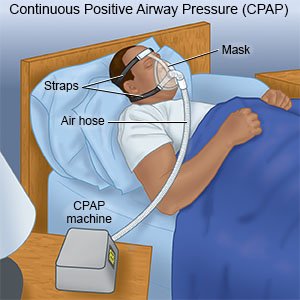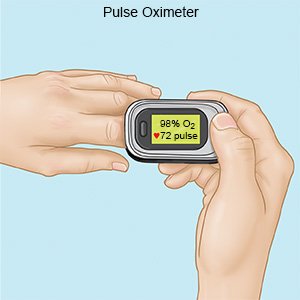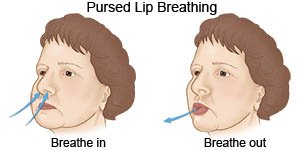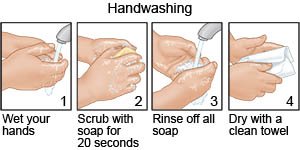Chronic Respiratory Failure
Medically reviewed by Drugs.com. Last updated on Apr 6, 2025.
What is chronic respiratory failure (CRF)?
CRF is a long-term condition that happens when your lungs cannot get enough oxygen into your blood. CRF can also happen when your lungs cannot get the carbon dioxide out of your blood. A buildup of carbon dioxide in your blood can cause damage to your organs. The decrease in oxygen and the buildup of carbon dioxide can happen at the same time. CRF may develop over a period of days to years.
 |
What causes CRF?
- Heart conditions such as left-sided heart failure or mitral stenosis
- Chronic obstructive pulmonary disease (COPD)
- A condition such as Guillain-Barré syndrome or myasthenia gravis that affects nerves or muscles used for breathing
- A lung condition such as cystic fibrosis or bronchiolitis
What are the signs and symptoms of CRF?
- Rapid breathing
- Shortness of breath, especially with activity
- A bluish color on your skin, fingernails, and lips
- Waking up with a headache or feeling very sleepy during the day
- Confusion or feeling like you never get enough sleep
- Swelling of your hands and feet
How is CRF diagnosed?
- An arterial blood gas (ABG) test measures the amount of oxygen and carbon dioxide in your blood. An ABG test also measures the pH of your blood.
- Pulse oximetry will show the decrease in blood oxygen without having to draw blood.
How is CRF treated?
Treatment depends on the cause and how severe it is. You may need any of the following:
- Medicines may be given to treat a lung or heart disease.
- Oxygen may be given if your blood oxygen levels are low.
- Ventilation helps get oxygen into your lungs and carbon dioxide out. Ventilation also makes the work of breathing easier. Some systems, such as a CPAP or BiPAP, may only be needed while you sleep. A mechanical ventilator may be needed some or all of the time. It is attached to a mask or breathing tube.

What can I do to manage or prevent shortness of breath?
- Check your oxygen level, if directed. Your healthcare provider may recommend you use a pulse oximeter (pulse ox). A pulse ox is a device that measures the amount of oxygen in your blood. You may be given an oxygen level goal for when you are at rest and another goal for activity.

- Use your oxygen as directed. You may need extra oxygen if your blood oxygen level is lower than it should be.
- Use pursed-lip breathing any time you feel short of breath. Take a deep breath in through your nose. Slowly breathe out through your mouth with your lips pursed for twice as long as you inhaled. You can also practice this breathing pattern while you bend, lift, climb stairs, or exercise. It slows down your breathing and helps move more air in and out of your lungs.

How do I manage CRF?
- Do not smoke. Nicotine and other chemicals in cigarettes and cigars can cause lung damage and make your symptoms worse. Ask your healthcare provider for information if you currently smoke and need help to quit. E-cigarettes or smokeless tobacco still contain nicotine. Talk to your healthcare provider before you use these products. Secondhand smoke can also make your symptoms worse. Avoid others who are smoking.
- Prevent the spread of germs. Wash your hands often with soap and water. Use gel hand cleanser when there is no soap and water available. Do not touch your eyes, nose, or mouth unless you have washed your hands first. Cover your mouth when you cough. Cough into a tissue or your shirtsleeve so you do not spread germs from your hands. If you are sick, stay away from others as much as possible.

- Limit alcohol. A drink of alcohol is 12 ounces of beer, 5 ounces of wine, or 1½ ounces of liquor.
- Ask about vaccines you may need. Vaccines can help prevent some lung infections. Examples include pneumonia, pertussis (whooping cough), tuberculosis (TB), and diphtheria. Get a flu vaccine every year as soon as it becomes available.
- Prepare for emergencies. Keep phone numbers for your healthcare provider, hospital, and someone close to you with you at all times. Also, keep a list of the medicines you take.
- Go to pulmonary rehabilitation (rehab). Your healthcare provider may suggest pulmonary rehab. Pulmonary rehab will educate you about your condition and will help you improve your quality of life.
Call your local emergency number (911 in the US), or have someone close to you watch and call if:
- You are having more trouble catching your breath.
- You have stopped breathing.
When should I call my doctor?
- You have new symptoms.
- Your symptoms get worse.
- You have questions or concerns about your condition or care.
Care Agreement
You have the right to help plan your care. Learn about your health condition and how it may be treated. Discuss treatment options with your healthcare providers to decide what care you want to receive. You always have the right to refuse treatment. The above information is an educational aid only. It is not intended as medical advice for individual conditions or treatments. Talk to your doctor, nurse or pharmacist before following any medical regimen to see if it is safe and effective for you.© Copyright Merative 2025 Information is for End User's use only and may not be sold, redistributed or otherwise used for commercial purposes.
Further information
Always consult your healthcare provider to ensure the information displayed on this page applies to your personal circumstances.
